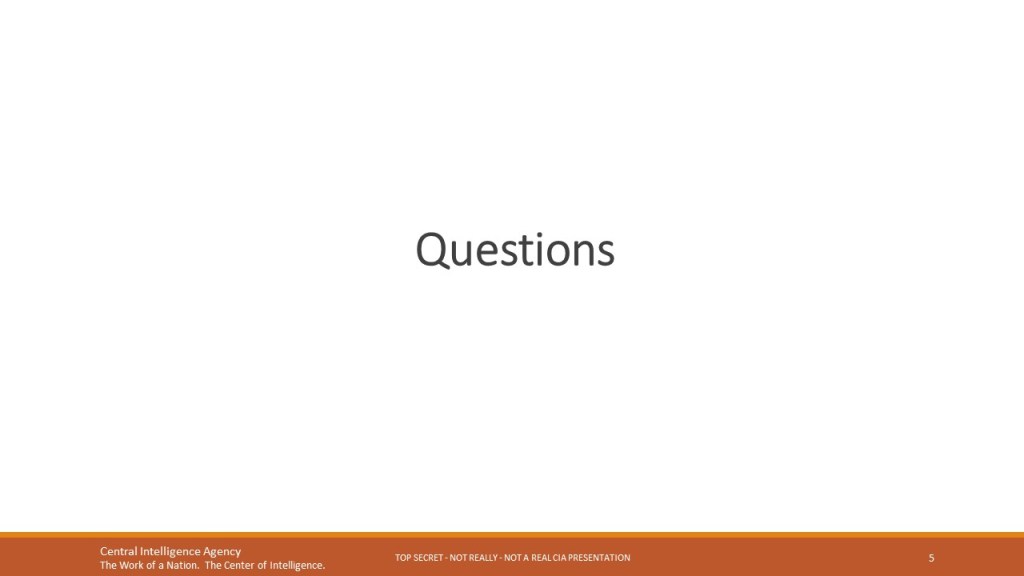In a previous post, I suggested that PowerPoint users should read Edward Tufte to understand the distorting effect that PowerPoint can have on presenting information. Yet, even when people find Tufte’s arguments credible (or even compelling), the cognitive style of PowerPoint is so entrenched in our world today that communicating in any other way can be difficult to imagine. This is particularly true for those whose first experiences making presentations—perhaps in high school or even younger—included a PowerPoint template. Given this, a way to imagine a world without PowerPoint is to look at the world before PowerPoint, and one window into that world is a short scene from a 30-year-old film, The Hunt for Red October (1990). And what is instructive (and a little fun) is picturing how that scene might play out today.
In this three-minute scene, Dr. Jack Ryan, a CIA analyst, is called on short notice to a briefing for top military advisors to the President of the United States. Set during The Cold War, Dr. Ryan has been researching photographs (obtained by British intelligence) of a new Soviet submarine, the Red October—photographs which reveal some concerning characteristics. Moments before entering the briefing room, Dr. Ryan asks his superior, Admiral Greer, “Who’s giving the briefing?” The Admiral responds, “You are.”
What follows is a textbook example of a briefing and one that should be watched by anyone wanting to deliver effective presentations. And yet, something is missing—the cognitive style of PowerPoint.
There are no bullet points in Dr. Ryan’s presentation. There are no sentence fragments projected onto a screen. Every sentence spoken provides clear information or adds context to his narrative. Images are clearly visible, not shrunk down and crammed into a single slide, making them difficult to see. Every image projected to the screen (like every sentence spoken) enhances Dr. Ryan’s narrative rather than detracting from it. Now consider how Dr. Ryan’s presentation would have played out had he used the slide deck below:
The first thing to note is that by the time Dr. Ryan completed his first sentence, each member of his audience would be focusing on something different. Take the first bulleted slide for example. Some in his audience would focus on the big takeaways on the left. Others would focus on the hierarchically arranged bullet points in the middle. And still others would focus on the images to the right, too small to make out. What they would not be focusing on—at least not in full—is what Dr. Ryan was saying.
As Tufte and many others have pointed out, the second we project sentences (or sentence fragments) onto a screen and begin to speak, our audience is faced with a decision: Listen to what we are saying or read the words on the screen. Audiences cannot effectively do both. (If you want to see this phenomenon in practice, try listening to your favorite podcast while browsing the latest headlines or your social media feed. In short order, you will be backing up your podcast to see what you missed.) The question for us as presenters is always, do we want the audience to listen to what we are saying or to read the sentence fragments we are projecting to a screen?
Another more amusing example of shoehorning clear information into a PowerPoint template is Peter Norvig’s Gettysburg Address slide deck, which is featured in Edward Tufte’s book Beautiful Evidence (2006). Yes, apparently even Abraham Lincoln would have benefited from sharing our country’s shared vision and critical success factors as an itemized list. (Not surprisingly, Norvig’s slides were the inspiration for my Jack Ryan slides.)
To be fair, there were bullet points and lackluster presentations before PowerPoint. They just weren’t so easy to make. Moreover, outside of sales and marketing departments, there was no pressure or impulse to put all information into anything resembling a PowerPoint template. And while we cannot blame a software application alone for crowding out more effective ways of sharing information, its grip on the professional landscape was swift and profound and remains so to this day.
So, for now, if you cannot imagine presenting information without PowerPoint, watch Jack Ryan’s briefing.
Up next: Why we abandoned other forms of sharing information so quickly and recommendations for kicking the PowerPoint habit, once and for all.







